Protect costly soft roll covers with novel mechanical devices
Soft rolls are prone to damage due to proximity to heat (for example heated thermo rolls). Polymer rolls are especially vulnerable. If the surface temperature of a polymer cover varies along its face or circumference, cracking can occur.

 |
CAUTION: Polymer covers can crack if exposed to excessive or uneven surface temperatures. Damaged covers can cause flying debris which could injure anyone near the rotating roll. To prevent this damage, follow all recommended roll care procedures and use any temperature sensors, cooling devices, or other roll protection devices as designed. |

Following recommended procedures can prevent some heat damage. For example, opening nips if there is no threaded sheet, rotating soft rolls whenever they are near a heat source, avoiding excessive heat, etc. Refer to roll documentation for further details.
A variety of mechanical devices can also be used to protect soft rolls from heat damage. These devices include:
- edge sensors
- edge coolers
- roll rotators
- temperature monitors
- internal roll temperature control system.
This document describes the typical design, principle of operation and maintenance of Valmet soft roll protection devices. Not all devices included here are used on all machines. Design details may also vary. Refer to project specific drawings and BOMs to determine which devices are used at your mill, and to understand the precise design or mounting of the equipment supplied.
Edge sensors
Edge sensors are used to detect the position of the sheet, and to sidelay it as needed to make sure that the edges of a soft cover are not exposed. Typically, the sensor is positioned to detect the edge of the sheet when the sheet is in the proper position. Feedback from the edge sensor is used to reposition the sheet as needed (for example by sidelaying the unwind stands on a calender). Typically, the edge sensor can be repositioned to move it out of the way during threading. In the example below, the sensor is mounted to a pneumatic positioning cylinder.
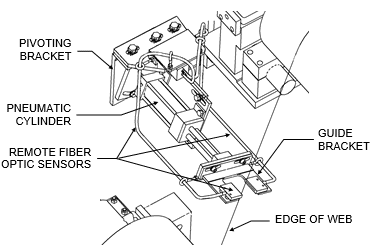
Typical edge sensor assembly
On some machines, the control system may be set up to react automatically to the feedback from the edge sensor. For instance, in the example mentioned above, the control system may automatically sidelay the unwind stand. On other machines, the operator may need to monitor the feedback from the edge sensor and manually correct the position of the sheet. Typically, edge sensors can be enabled or disabled using operator controls. Refer to control schematics, control screens, or control explanations for project-specific information.
Maintenance of edge sensors
- Confirm receipt of feedback from remote sensors. Refer to component datasheets for troubleshooting information.
- Inspect any positioning devices (such as cylinders) for proper operation. Refer to component datasheets for maintenance or repair information.
Edge coolers
While threaded, the web covers most of the surface of a roll, acting as an insulator between a soft roll cover and a heat source (such as a thermo roll). However, the web does not usually span the entire face of the cover, so the edges of the cover are exposed to the full heat from the heat source. This causes temperature differentials across the face of the cover, which can lead to cracking, especially with polymer rolls. Edge coolers are used to compensate for the excess heat applied to the exposed roll edges. They do this by directing cool air toward the ends of the roll. The air is typically left on at all times, except during maintenance.
Valmet edge cooler designs typically fall into one of two categories: air knives or vortex tubes. Typically, there are two edge cooler assemblies, one at each end of the roll. Edge coolers are typically mounted on adjustable brackets to allow precise positioning.
Air knives
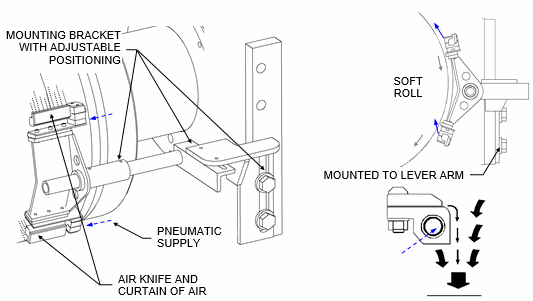
Typical air knife edge cooling device
Air knives use a small amount of compressed air as a power source to pull in large amounts of surrounding air, producing a high flow, high velocity curtain of air. The knives are typically positioned to direct the curtain of air upward toward the edges of the roll cover, flowing opposite to the rotation of the roll.
Vortex tubes
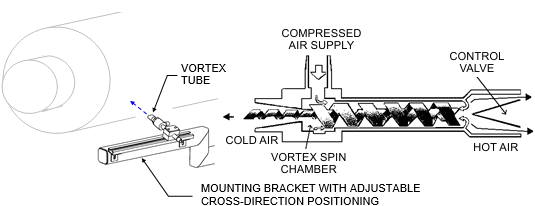
Typical vortex tube edge cooling device
Vortex tubes use compressed air, a vortex spin chamber and a control valve to cool the air streaming out of the vortex tube. The tubes are typically positioned to direct a high velocity stream of air toward the edges of the roll cover, flowing opposite to the rotation of the roll.
For maintenance of air knives and vortex tubes, refer to drawings and supplier datasheets.
Temperature sensors
Temperature sensors may be used to detect the temperature of a soft roll. Typically, infrared sensors (IR cameras) are used. Infrared sensors detect the amount of infrared radiation emitted by an object (in this case the soft roll cover). This information is then used to calculate the object’s temperature. Feedback from the sensors is typically displayed at the operator control station. Typically, the operator will need to monitor for excessive or uneven temperatures.
Depending on design considerations, the temperature of the cover may be detected using multiple, fixed-position cameras or a single, traversing one. Traversing cameras are typically mounted on a track, with a motor which moves the camera from one end of the roll and back.

Typical mounting of roll temperature sensors
In the figure, (a) shows three sets of IR cameras per roll and (b) shows a single IR camera mounted on a track. The number of sensors and locations may vary.
To ensure accurate measurements, make sure to keep the camera lens and the roll surface clean. Oil, grease and other contamination on the rolls can affect changes in the cover's emission factor, resulting in incorrectly measured temperatures. Particles on the camera lens can impair the function of the camera.
Infrared sensors are typically mounted in an air-purged protective casing to prevent dirt particles from depositing on the lens. The air should be on at all times except while cameras are being replaced.
Refer to supplier datasheets for re-calibration or adjustment procedures and for maintenance of traversing components.
Roll rotators
Soft rolls exposed to a heat source (such as a thermo roll) should be rotated even when the nip is open and the roll is no longer in direct contact with the heat source. With the roll stationary, the roll surface closest to the heat source becomes heated while the rest of the cover begins to cool down. This causes a circumferential temperature differential, which can lead to cracking.
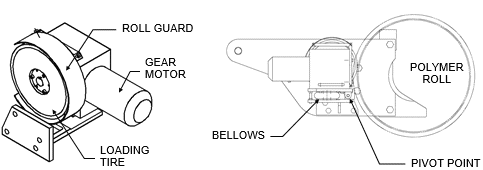
Typical soft roll rotator
Roll rotators are used to slowly turn polymer rolls while the nip is open. This distributes the heat by varying the surface exposed to the heat source.
Typically, there is one roll rotator per polymer roll. The roll rotating device consists of a tire, bellows, gearmotor, and a pivoting frame. When engaged, the bellows are pneumatically inflated which pivots the frame to load the tire against the polymer roll journal. The tire is slowly rotated by the gearmotor, which in turn rotates the polymer roll.
Maintenance of roll rotators
- Check the loading tires for wear and replace if worn.
- Check oil levels in the gearbox. Refer to the gearbox supplier datasheets.
Internal roll cooling
Although unusual, some soft rolls have an internal fluid system which is intended to cool the roll and/or maintain a consistent temperature across the roll. Three methods for internally cooling a roll are described here.
The first method (depicted below) uses a closed loop system and a dedicated temperature control unit to continually circulate cooled process water through the soft rolls. This system is comparable to a thermo roll temperature control system except that it cools the soft roll instead of heating it. Heat from the soft rolls transfers to the circulating process water, warming it up. The process water then circulates through a heat exchange unit where the heat from the process water is transferred to the much cooler tap water (mill water) which is also circulating through the unit. This warms the mill water and cools the process water. The warm mill water is then flushed while the cool process water returns to the soft rolls in a never-ending cycle. The process and mill water typically flow in and out of the roll through rotary unions.
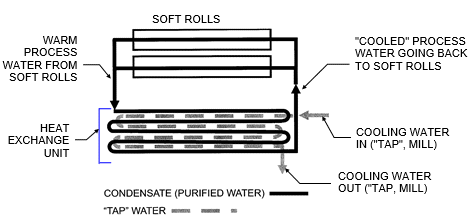
Typical soft roll temperature control system with a heat exchange unit (Note: The number of rolls and pathways will vary, so refer to your fluids drawings.)
Equipment warranties typically require the use of purified water (condensate) to prevent roll corrosion. Refer to OEM component datasheets for further information.
The second method is similar to the first except that it does not have a separate heat exchanger.
The third method takes a different approach. A cooling fluid (typically a water/glycol mixture) is sealed inside the hollow shell of the soft roll. The fluid rotates inside the shell as the roll moves, absorbing and neutralizing temperature inconsistencies along the surface. This method is designed to distribute the heat evenly across the roll rather than actively cooling it. Typically, there are no rotary unions in this design.
For more information about protecting your soft roll covers, contact your Valmet representative.